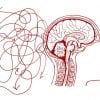Summary: Study reveals how reward enhances connectivity between the ventral striatum and the default mode network, impacting behavior.
Source: Kessler Foundation
Researchers have reported findings that add to our knowledge of how human behavior may be shaped by the default mode network, a specific network of brain regions with both resting and task-related states.
The default mode network (DMN), which comprises the posterior medial cortex, medial prefrontal cortex, and lateral temporal-parietal regions, has been shown to be engaged in several task-related behaviors. Studies show that DMN activity increases during inward-directed thought and decreases during externally directed tasks requiring focused attention.
Despite evidence for a role for the DMN in shaping behavior, little is known about how task-related changes in the DMN influence connectivity with other brain regions. For example, while some observations indicate an indirect relationship between the DMN and the striatum, how the DMN and striatum interact during tasks remains unclear.
To further explore the functions of the DMN, Drs. Dobryakova and Smith applied a novel analysis to the reward task, using behavioral and neuroimaging data from 495 randomly selected individuals in the Human Connectome Project, an open access database of healthy participants.
The goals of this network-based psycho-physiological interaction analysis were twofold, according to Dr. Dobryakova, a senior research scientist in the Foundation’s Center for Traumatic Brain Injury Research.
“First, to test the effects of reward on connectivity between the DMN and the striatum; and second, whether such connectivity is associated with behavioral and personality characteristics relevant to reward processing,” she explained.
In line with other studies, during the task, they observed decreased activation of the DMN and relative increased activation of other networks.
“Most notably, we found that the experience of reward enhanced connectivity between the DMN and the ventral striatum,” Dr. Dobryakova reported, “an effect specific to the DMN. We were also surprised that the strength of this connectivity correlated with personality characteristics relating to openness,” she added.
Greater understanding of the workings of the healthy brain will influence future research and care for individuals with neuropsychiatric syndromes. “Improving our understanding of the interaction of the DMN with other brain networks has the potential to aid clinical research into better treatments for common syndromes such as depression, substance abuse, and schizophrenia,” Dr. Dobryakova concluded.
Funding: This research was supported by grants from the National Institutes of Health grants R21-MH113917 (DVS), R03-DA046733 (DVS), RF1-AG067011 (DVS), R01-NS121107 (ED).
About this reward and behavior neuroscience research news
Author: Carolann Murphy
Source: Kessler Foundation
Contact: Carolann Murphy – Kessler Foundation
Image: The image is in the public domain
Original Research: Open access.
“Reward enhances connectivity between the ventral striatum and the default mode network” by Ekaterina Dobryakova et al. NeuroImage
Abstract
See also

Reward enhances connectivity between the ventral striatum and the default mode network
The default mode network (DMN) has been theorized to participate in a range of social, cognitive, and affective functions. Yet, previous accounts do not consider how the DMN contributes to other brain regions depending on psychological context, thus rendering our understanding of DMN function incomplete.
We addressed this gap by applying a novel network-based psychophysiological interaction (nPPI) analysis to the reward task within the Human Connectome Project.
We first focused on the task-evoked responses of the DMN and other networks involving the prefrontal cortex, including the executive control network (salience network) and the left and right frontoparietal networks.
Consistent with a host of prior studies, the DMN exhibited a relative decrease in activation during the task, while the other networks exhibited a relative increase during the task. Next, we used nPPI analyses to assess whether these networks exhibit task-dependent changes in connectivity with other brain regions.
Strikingly, we found that the experience of reward enhances task-dependent connectivity between the DMN and the ventral striatum, an effect that was specific to the DMN. Surprisingly, the strength of DMN-VS connectivity was correlated with personality characteristics relating to openness.
Taken together, these results advance models of DMN by demonstrating how it contributes to other brain systems during task performance and how those contributions relate to individual differences.